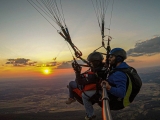The Camino de Santiago is the perfect opportunity to enjoy outdoor sports and discover part of our country's history, as this activity has been practised since the 9th century. It was during this time that the tomb of Saint James the Great, the evangelist of Spain, was discovered.
The routes to Santiago vary but all culminate at the same point: The Cathedral of Santiago de Compostela. Whichever path you choose, one thing is certain - you'll find a whole world to explore and, as you'd expect, you'll meet all sorts of people with different lifestyles and backgrounds, with whom you'll enjoy every step of the journey.

It's such a comprehensive activity that you can even do it by mountain bike, so if you're passionate about two-wheeled adventures, stop wondering whether you can bring your bike - the answer is yes. However, it's crucial to follow some recommendations, as the Camino is not to be undertaken lightly.
We strongly advise planning your trip carefully beforehand to choose your route wisely. Additionally, you'll need proper equipment and should avoid unnecessary luggage - pack only what you'll genuinely need, as anything superfluous may become a burden once you've started your trek.
For bike transportation, you'll find numerous services available. One option is to have your bike shipped to your starting point via courier, then arrange for its return home while you travel back by train or other means. The pilgrim's office and hostels can provide information about companies specialising in bicycle transport across the country.

Once there, be sure to follow the yellow arrows marking the route, especially if you choose the French Way, which is particularly well-signposted. Most importantly, remember the Camino isn't a race to the cathedral - you'll need to adapt to each day's circumstances as they arise. Weather conditions, hostel availability, and trail congestion can't be predicted in advance.
Another piece of advice relates to stage endings, as most pilgrim guides typically suggest finishing at the same locations. With stages usually being 25 to 30 kilometres long, many people head to the same hostels, which might leave you without accommodation.

Staying hydrated throughout the day is essential, given the considerable distances covered. During summer, sun protection is vital: sunscreen, sunglasses, etc. Winter presents more challenges, as rainfall can make progress along the path more difficult.
If you're considering doing the Camino de Santiago by mountain bike, don't hesitate - let yourself be carried away by an unforgettable experience. As the saying goes, "There's a before and an after the Camino." Why not see for yourself if it's true?











